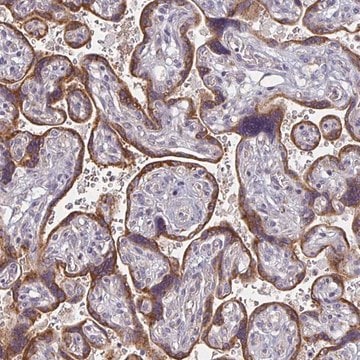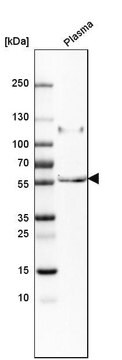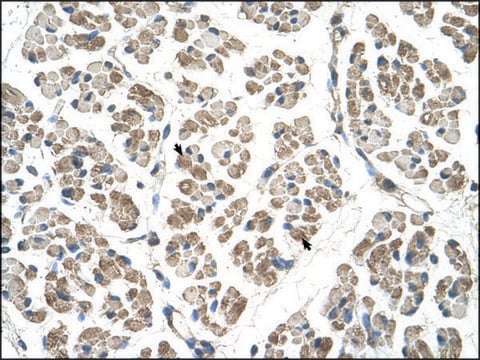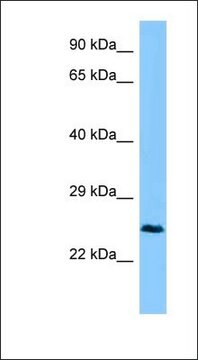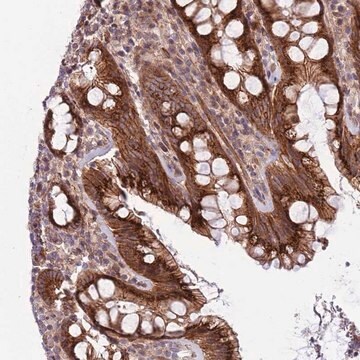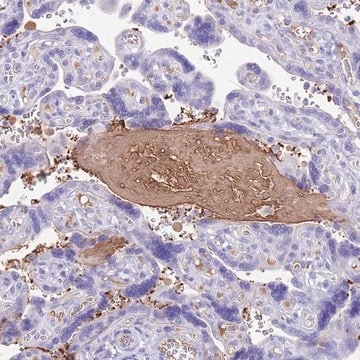MABT889
Anti-CTHRC1 Antibody, clone Vli-55
clone Vli-55, from rabbit
Sinonimo/i:
Collagen triple helix repeat-containing protein 1, Protein NMTC1
About This Item
Prodotti consigliati
Origine biologica
rabbit
Livello qualitativo
Forma dell’anticorpo
purified antibody
Tipo di anticorpo
primary antibodies
Clone
Vli-55, monoclonal
Reattività contro le specie
rat, mouse, human, porcine
tecniche
immunohistochemistry: suitable
western blot: suitable
N° accesso NCBI
N° accesso UniProt
Condizioni di spedizione
wet ice
modifica post-traduzionali bersaglio
unmodified
Informazioni sul gene
mouse ... Cthrc1(68588)
Descrizione generale
Specificità
Immunogeno
Applicazioni
Western Blotting Analysis: Representative lots detected exogenously expressed human and rat CTHRC1 in lysates from transfected cells (Duarte, C.W., et al. (2014). PLoS One.;9(6):e100449; Stohn, J.P., et al. (2012). PLoS One. 7(10):e47142).
Western Blotting Analysis: A representative lot detected the overexpressed Cthrc1 in plasma samples from Cthrc1 trangenic mice, as well as immunoprecipitated CTHRC1 from normal human plasma samples (Stohn, J.P., et al. (2012). PLoS One. 7(10):e47142).
Immunohistochemistry Analysis: A representative lot detected increased Cthrc1 expression in interstitial cells and activated fibroblasts of various remodeling tissues from wild-type, but not Cthrc1-null mice following angiotensin II infusion by immunohistochemistry staining of paraformaldehyde-fixed, paraffin-embedded sections (Duarte, C.W., et al. (2014). PLoS One.;9(6):e100449).
Immunohistochemistry Analysis: Representative lots immunostained Cthrc1-positive cells in paraformaldehyde-fixed, paraffin-embedded human, pig, and rat pituitary gland tissue sections (Duarte, C.W., et al. (2014). PLoS One.;9(6):e100449; Stohn, J.P., et al. (2012). PLoS One. 7(10):e47142).
Immunohistochemistry Analysis: A representative lot immunostained adventitial cells of remodeling renal artery, dermal cells in skin wounds, embryonic cartilage, as well as midbrain of wild-type, but not Cthrc1-null mice, using paraformaldehyde-fixed, paraffin-embedded tissue sections (Stohn, J.P., et al. (2012). PLoS One. 7(10):e47142).
Immunohistochemistry Analysis: A representative lot localized Cthrc1 immunoreactivity in various regions of paraformaldehyde-fixed, paraffin-embedded mouse and pig brain sections (Stohn, J.P., et al. (2012). PLoS One. 7(10):e47142).
Cell Structure
Adhesion (CAMs)
Qualità
Western Blotting Analysis: 10 µg/mL of this antibody detected CTHRC1 in 10 µg of human brain tissue lysate.
Descrizione del bersaglio
Stato fisico
Stoccaggio e stabilità
Altre note
Esclusione di responsabilità
Not finding the right product?
Try our Motore di ricerca dei prodotti.
Codice della classe di stoccaggio
12 - Non Combustible Liquids
Classe di pericolosità dell'acqua (WGK)
WGK 1
Punto d’infiammabilità (°F)
Not applicable
Punto d’infiammabilità (°C)
Not applicable
Certificati d'analisi (COA)
Cerca il Certificati d'analisi (COA) digitando il numero di lotto/batch corrispondente. I numeri di lotto o di batch sono stampati sull'etichetta dei prodotti dopo la parola ‘Lotto’ o ‘Batch’.
Possiedi già questo prodotto?
I documenti relativi ai prodotti acquistati recentemente sono disponibili nell’Archivio dei documenti.
Il team dei nostri ricercatori vanta grande esperienza in tutte le aree della ricerca quali Life Science, scienza dei materiali, sintesi chimica, cromatografia, discipline analitiche, ecc..
Contatta l'Assistenza Tecnica.